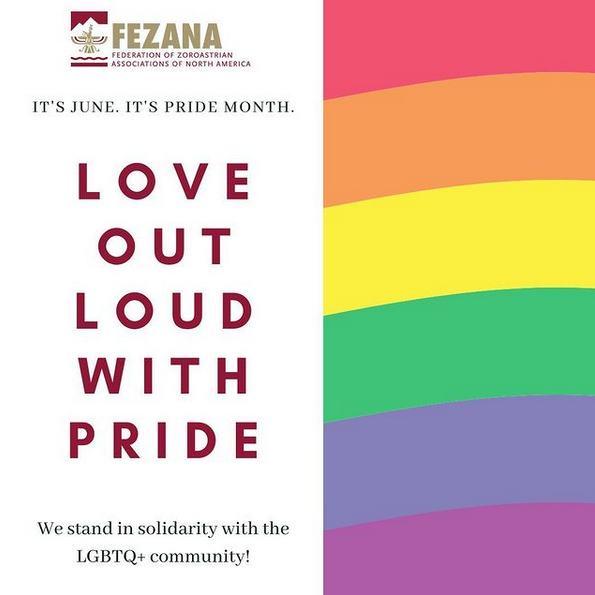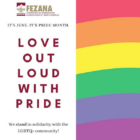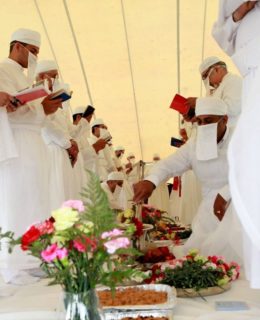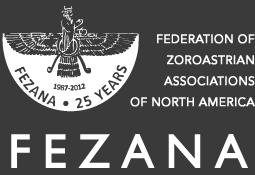This article has been updated since it was first published. Updates noted at the end of the article
This is a series of articles curated by Maya Joshi a member of ZYNA: Zoroastrian Youth of North America, a FEZANA committee.

An Introduction
By Maya Joshi
As we celebrate our Zoroastrian members of the LGBT+ community this Pride month, we must all recommit ourselves to the Zoroastrian values of education, compassion, truth, light, and love. We must choose to better our understanding and acceptance of our world and the lovely people in it, and fight for the justice and equality that all human beings find so dear to us.
I started the Pride Project 2021 because queer Zoroastrians need to know that not only are we not alone, we have a whole community within the religious community who we can relate to and share our unique struggles with. Friends, mentors, and colleagues alike, who all understand that queer Zoroastrians deserve love and to have a visible place within the religious community. Pride Project 2021 is a series of writings by queer Zoroastrians from around the world on the intersection of religiosity and queerness.
What is LGBT+? What does it mean to be queer?
LGBT stands for Lesbian, Gay, Bisexual, Transgender, and the plus sign is included to indicate the many more existing sexualities and gender identities that aren’t discussed as much, such as Asexual and Intersex. Queer is an umbrella term that many people who aren’t cis-gender and heterosexual use, as it covers everything and is vague enough that many feel more comfortable using it rather than saying a specific label that they feel may or may not fit them perfectly, or may make them face unnecessary difficulties due to other people’s confusion or outright hatred.
Today is the anniversary of June 28th, 1969, when the mass response of the United States LGBT+ community towards oppressive police violence known as the Stonewall riots inspired many to fight for their rights. Stonewall became a rallying point for marched and protested, first against discrimination and homophobic violence, then against the actions of an indifferent government that actively ignored a disease that decimated entire portions of the American population, just because the people dying in the hundreds of thousands were not heterosexual and therefore an undesirable population in the government’s eyes. Eventually, the marches became a celebration of our existence in the face of hatred, the beauty and diversity of the community, and the strength and pride it required for people to live and love authentically, in a way that’s true to themselves. That strength and resilience, that commitment to truth, is something that I refuse to believe our beautiful religion could ever be against. Love is love, always worthy of celebration. Happy Pride!
Being Zoroastrian And Gay
By A Gay Doctor from Mumbai, India
The first time I had any sense of what Zoroastrianism was, I must have been about 8 or 9 years old; and the first time I realised that I was not straight, I must have been about 13 years of age. Discovering who I was, as a Zoroastrian and being gay, both have been quite similar journeys. My grandmother used to tell me stories of Zoroastrianism all the way from the great Zoroastrian kings and queens that ruled ancient Persia to the migration of the Parsis from Iran to India. They were essentially the foundations for me to know the history and culture of my people. But out in the real world, besides my family, I hardly ever found or came in contact with other Zoroastrians, especially those from outside of India. And I had accepted the fact that there aren’t many of us out there. But still I kept in touch with my traditions and prayed like any obedient Zoroastrian would.
Around the time I hit puberty, I realised that I wasn’t like every other guy around me. They would talk about girls and I would just not feel right. At first I just rebuffed it saying that with time I will probably like girls as well. But as I got older I realised that this was not the case for me. I came to a slow realisation that I was attracted to boys rather than girls. Being a young teenager I didn’t understand what was happening to me. So I searched on Google what was wrong with me. And the first thing that popped up was HOMOSEXUALITY. I started reading up on wiki and Google as to what homosexuality was. It was then that I realised that I was gay.
So the next thing I did was to try and see if there was anyone from our community who was just like me, someone who could guide me or explain to me what was happening to me. And to my surprise I found absolutely no one. I felt so alone in that moment. I felt as if I was a defect in this perfect community of heterosexuals. I had no role models around me. To make matters worse, when I searched for Zoroastrianism’s stance on homosexuality on wiki, what I read just shattered me. It reads to this day, “Homosexuality is a form of demon worship, and thus sinful. Ancient commentary on this passage suggests that those engaging in sodomy could be killed without permission from the Dastur, the high priest.”
The religion I was so passionate and cared about thought that I should be killed because I loved men. I didn’t want that to happen to me nor did I want my parents to find out. So I started praying, as hard and sincerely as I could. The loneliness would eat me inside out and would land me into severe depression. When I saw that my prayers weren’t being answered, I almost cut off with everything Zoroastrian from my life and became a rebel. By the time I reached medical school in a different city I was at an all time spiritual low. Out here away from everyone I knew, I started meeting people of the LGBTQ community. Many of them helped me to figure who I was. Some were even religious. Over time I found other Parsi LGBTQ members and started to exchange stories and life experiences. I even started coming out to the people close to me. When I told my parents finally they were a little taken aback but they bounced right back and support me wholly.
Soon after this I started my spiritual journey again, this time to find my place in this community as a gay Zoroastrian. Around that time I found the Zoroastrian LGBT-Straight Alliance group. On that platform I found so many who were like me. I found friends there that I had craved for since I tried to figure out who I was. And when, during the World Zoroastrian Youth Congress, the 1st LGBTQ discussion panel was held, I stayed up late all night just to watch it. All of that made me realise that I wanted to do something too for the LGBTQ people within our community. Soon I found myself on a journey to help other young Zoroastrians, who like me are feeling lost and want a safe space to speak their mind. I created an LGBTQ group on Facebook called QueerZ where only LGBTQ members of our community can join discreetly and find others like themselves on this group.
Today I’m at a stage where I am just as spiritually connected to my faith as I was before. I also hope someday I find a nice Zoroastrian guy who I can marry and raise our kids within this very faith.
Embracing my sexuality… the truth of it has made me more Zoroastrian
By Fereshteh Dinaz Balsara
Being Zoroastrian and being gay are not mutually exclusive. After all, being Zoroastrian is a way of life, a way of thinking, a way to exist.
Propagating good in the world; seeking the truth.
Yes, I have faults and flaws and moral dilemmas, but isn’t that the purpose of religion? I grew up learning it was my Zoroastrian duty to be honest and kind, to choose the path of righteousness, to fight for good in this world!
My religion never imposed upon me the day-to-day of what to eat, how to dress, or what sort of gender expression to have.
Ahura Mazda gave us our minds and the ability to reason,
to decide what is right,
decide what is true.
So being a tomboy and having crushes on girls and young women around me never contradicted my religious duty.
In fact, my relationship with Ahura Mazda strengthened as I reasoned and struggled and accepted my own reality…
…and asked for strength as I struggled.
What did Zarathustra say about how we should conduct ourselves?
Men and women are equal.
Good thoughts lead to Good words and those lead to Good deeds.
We are responsible to care for our environment and the people on this earth.
Nothing about who to fall in love with! Just how to love.
To love and respect all beings, to treat your enemy with kindness, to care for the natural environment, to always continue learning with an open mind and heart. To seek the truth.
Ahura Mazda gave me this family, this religion, this mind and this body. Where is the contradiction between my sexual orientation or gender expression and our religion? You tell me.
Because this is the Truth for me, My Truth.
Anything other than that would be denying the truth… precisely against my religion.
And so, in the end, embracing my sexuality… the truth of it has made me more Zoroastrian.
Why I am Proud to be a Bisexual Zoroastrian
By Almithra Daroga
Growing up a Zoroastrian has always been something that I have been proud of. Since it is a smaller religion than most, our community has always been brought together by a shared experience of being a minority in the U.S. Our faith has always taught us that compassion, kindness, and love for others is of the utmost importance. These teachings along with others we have learned have created a strong and valuable bond between our community. I have always appreciated that our religion allows us to practice free will. I feel as though this has created a safe environment for LGBTQ+ Zoroastrians to practice our faith.
When I was in my sophomore year of high school, I suspected that I may be bisexual. I did not know what bisexuality was at that time. I only knew how I felt, so I started researching and found a term for my feelings. Bisexuality is the experience of attraction to more than one gender. When I found out that I was a member of the LGBTQ+ community, at first I was terrified. I didn’t know how being bisexual would affect me.
I started to do more research on LGBTQ+ matters and found out that many religions spoke harshly about the issue. They preached on its wrongness and said that people who identify within that community had no place in the religion. As I thought back to our own religion and our own community, I realized that I did not feel as though I would be treated that way. Instead, I felt that while some in our community may disagree with who I am, I would still be welcome to practice the religion. I felt as if those who didn’t agree with me being bisexual would still treat me with respect and not make me feel like an outsider in my own religion.
I have come to be proud of my sexual identity as I am how Ahura Mazda made me to be. It has taught me to be a more accepting and understanding human being. I now know that I can live as my true self and still be strong in my faith with a community that supports me.
PRIDE: In Conclusion
By Maya Joshi
When I first came out to the religious people in my extended family, especially the older ones, I wanted to show them that I wasn’t the first queer Zoroastrian to be out and proud. I wanted to calm their fears that I would be mistreated by the community or end up unhappy and alone by giving them examples of others who were successful and happy and treated well by the community. But the only example I could find was Freddy Mercury, AKA Farokh Balsara, who was a bisexual Parsi and a world famous rock star. But his story did end tragically, as his life was cut short by AIDS, a deadly disease that the most powerful governments of the world were happy to ignore because it was primarily killing gay men. Now, in 2021, there are plenty of examples of successful queer Zoroastrians, from influential gay poets and award winning lesbian astrophycisists to gay mobeds who do drag and respected college professors. We are many, beautiful and diverse and successful and happy. But are we accepted? When I get married, will the same people who came to my Navjote come to the wedding if there are two brides and no grooms? I have to hope that they will, that other Zoroastrians outside of my loving family will celebrate my love and life no matter the gender of the person I join it to. Because the other option is that the religion I believe in and love with all my heart is hateful and divisive, and not at all the virtuous source of truth, love, and light I’ve always thought of it as.
FEZANA Note: The views expressed above are those of the individual authors. They are not the official views or stance of ZYNA or of FEZANA.
Update on 07.26.2021:
The above article has been updated to remove a post by one of the authors. At FEZANA we would love to share the opinions and voices of our community and our young adults. At times the fine line between opinion and academic interpretation of texts and statements thereof, gets blurred. Our intention is always to do the right thing, for the organization, its members and the community at large, and hence the action.
Below is an edited version of a response that FEZANA would like to share, with prior permission of the author.
Sincerely
Arzan Sam Wadia, President; FEZANA
president@fezana.org
Ervad Zarrir Bhandara writes…
The translation of Hom Yasht/ Yasna 9.1 is as follows, “During the Hāvan Gāh Hom (yazata) came to (the Prophet) Zarathushtra (who was) purifying the fire and (was) chanting the Gathas. (The Prophet) Zarathushtra asked him: O man! Who art thou? Whom do I see, the most excellent (and) beautiful and of immortal life in the entire corporeal world. Thereupon that Hom, the righteous, warding off sickness replied unto me: O Zarathushtra! I am Hom, the righteous, warding off sickness …..” TRANSLITERATED AND TRANSLATED INTO ENGLISH With Copious Explanatory Notes Prepared by Prof. Ervad MANECK FURDOONJI KANGA M.A. from the Gujarati original Khordeh-Avestā-Bā-Māyeni of Ervad KAVASJI EDULJI KANGA. (First Edition published in 1880 and Thirteenth edition in 1976.) FIRST EDITION IN ENGLISH 1362 A.Y. – 1993 A.C. Corrected edition 1382 A.Y. – 2014 A.C. Page 287. Apām Napāt is very much visible in Uziren geh, Ava Ardavisur Niyayesh, Avan Yasht, and Ashisvang Yasht.
We respect and accept LGBTQ individuals, but that does not mean that any individual can manipulate our revered scriptures & thereby disrespect our religious sentiments by demeaning our prophet, which is not acceptable.
Our prophet has been given the status of Yazata, a SPIRITUAL being worthy of worship; it is believed that the light projected from his Kehrpa- astral body – was visible for ¼ of a mile. Therefore, it is not right to reduce his existence to that of just a physical being.
Regards
Ervad Zarrir Bhandara
Officiating priest
Zoroastrian Association of California





